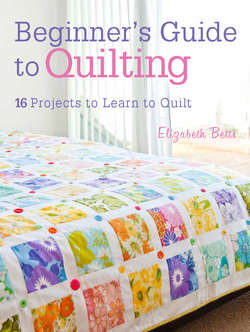Читать книгу Beginner's Guide to Quilting - Elizabeth Betts - Страница 9
На сайте Литреса книга снята с продажи.
ОглавлениеRotary cutting
The first few projects in this book are sewn by hand, and can be made without a rotary cutter, mat and ruler. However, if you get hooked on quilting, then a set is an essential piece of kit.
If looked after, they should last a long time. The only extra item you will need to buy is a replacement blade for your rotary cutter when it starts to blunt.
Rotary cutter: These come in a few sizes, but the 45mm is the one most widely used for patchwork. There are different types, so see if you can try a few before deciding on which one to buy.
Self-healing mat: Make sure you store your mat flat as it can warp. Mats have measurements on them in inches or centimetres, but I usually only use the measurements on my acrylic ruler.
Acrylic ruler: I find the most useful ruler to use is a long, rectangular ruler measuring 24in × 61⁄2in. This is long enough to cut 44in (110cm) wide fabric folded in half. I find a 121⁄2in (31.7cm) square and a 6in (15.2cm) square handy to have too. Rulers are available in both imperial and metric measurements; however, I would use them as you would a recipe – don’t mix the two on the same project.
Cutting strips and squares
Adapt this method to whatever size of square, rectangle or strip you need to cut. Once you have got used to using the equipment, you will find it a quick and accurate way of cutting fabric.
The instructions below are for a single layer of fabric; you can, however, cut several layers with a rotary cutter. When cutting layers, keep them lined up by spinning the board round so it is in the right position to cut, rather than lifting up the fabric as it will shift and make your next cut less accurate.
To help cut the fabric on the straight of the grain, line up the bottom of the ruler with the selvedge for the first cut. Then trim off the selvedge and put this to one side, so you don’t accidentally use a piece of fabric that has the selvedge on it in the quilt. The selvedge also pulls in the fabric near it, so cutting it off helps the fabric relax and lay flat.
Before you start, read through the safety tips.
1 Lay the fabric on a cutting mat. Place the ruler at a right angle on the edge of the fabric and trim off a small amount of fabric to make a straight edge. This starts to square up your fabric.
2 Turn the fabric round, and line up the 4in (10.2cm) line on your ruler with the straight edge of the fabric and cut a strip. Repeat to cut as many strips as required.
3 Lay out a strip. Line the edge of the fabric with the edge of the ruler and cut. The end of the fabric now has three perfect 90-degree angles. You can now cut off as many squares as you need, using the measuring line on the ruler for reference.
Safety tips
A rotary cutter is a circular blade. You need to take care with this tool as accidents can occur.
• Every time you finish cutting, cover the blade immediately.
• Cut away from you in one movement.
• Always use your acrylic ruler; never be tempted to use a normal one.
• Be careful to ensure that your fingers are not over the edge of the ruler when you cut.
• If you feel the ruler slip when you cut, buy some sticky pads to apply to the ruler to keep it in place. You can also stop cutting halfway up a piece of fabric, move your hands up, then continue cutting.
• Take care when changing the blade on your cutter. It will need changing when it stops cutting correctly.
• Discard old blades carefully.
